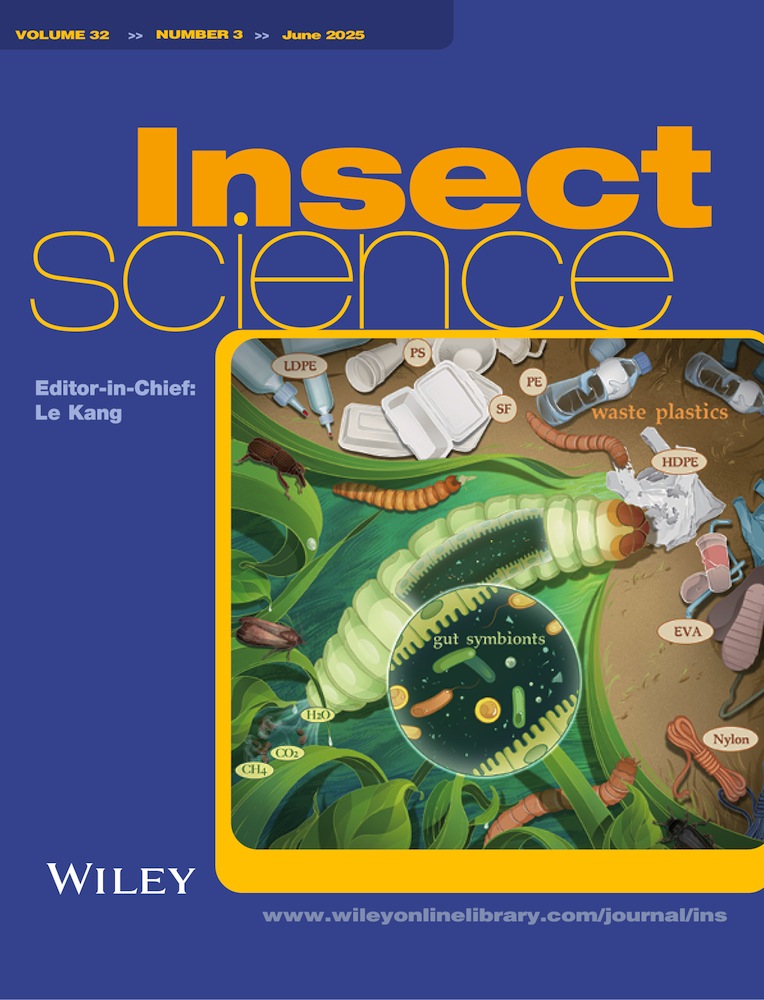A long cold storage protocol for Anisopteromalus calandrae based on promoting prepupal development and arresting early pupal growth under low temperature
Abstract
Anisopteromalus calandrae (Howard) shows great promise as an ectoparasitoid for controlling various coleopteran pests in warehouses. However, for a large-scale release, it is crucial to establish an ample supply of A. calandrae while carefully maintaining their quality and effectiveness. Appropriate cold storage techniques are the key to achieving these goals. Previous studies on cold storage have focused on specific developmental stages and explored cold storage conditions that can be applied only to those stages. Herein, we examined the development, survival and reproductive capacity of A. calandrae at different temperatures (13, 16, and 19 °C) and storage durations (30, 60, and 90 d) and evaluated the fitness of the offspring. A. calandrae completed its egg-to-larva development and pupated at 16 °C, but its development was arrested at an early pupal stage. Even after 90 d of cold storage at 16 °C, the survival rate of A. calandrae remained high at 77%, with no significant impact on reproductive capacity. Furthermore, cold storage showed no negative effect on the F1 generation. In contrast, eggs stored at 13 °C failed to hatch, whereas those stored at 19 °C developed. Adults emerged after > 60 d. This indicates that storage at 19 °C is only suitable for short durations. Our findings highlight the developmental pattern of A. calandrae at 16 °C, indicating that the parasitic wasp can be stored for a long time at this temperature across all stages of development before pupation, substantially facilitating its mass reproduction and industrial production.
Introduction
Recently, the use of parasitoid wasps in biological control programs has gained significant attention as a sustainable and environmentally friendly method of managing agricultural pests (Wang et al., 2019). Anisopteromalus calandrae (Howard), a parasitoid wasp, has shown promise in controlling coleopteran pests of stored products, particularly stored grains (Chaisaeng et al., 2010; Nam et al., 2011; Solá et al., 2020; Zhang et al., 2022; del Arco et al., 2023; Yu et al., 2023). Although the indoor artificial reproduction technology for A. calandrae has matured, the successful implementation of parasitoid-based pest management strategies is contingent on the effective preservation and storage of these beneficial insects (Yu et al., 2023).
Studies have demonstrated the efficacy of cold storage as a valuable technique for prolonging the shelf life of the natural enemies of pests, ensuring a consistent and ample supply of insects for biological control programs (Colinet & Boivin, 2011; Morales-Ramos et al., 2023). Low temperatures that slow down developmental rates are primarily used in the storage of most parasitoids (Morrison & King, 1977). Researchers have attempted to store the natural enemies of pests at various developmental stages (i.e., egg, larva, prepupa, pupa, and adult) (Guzman & Petersen, 1986; Mahi et al., 2014; Askari Seyahooei et al., 2018; Yang et al., 2024). The early pupa of A. calandrae can be stored for up to 90 d at 13 °C, demonstrating adequate cold storage effectiveness (Yang et al., 2024). However, these studies have focused on the survival performance of pests at specific developmental stages under cold storage conditions and explored cold storage conditions that can be applied only to those stages. Based on these reports, parasitoid wasps require some time to uniformly reach a specific developmental stage before cold storage, which is inconvenient in the actual production.
The current study employed a different approach by exploring cold storage conditions that can be applied to a broader range of developmental stages of A. calandrae. Specifically, at low temperatures, these parasitoid wasps can feed on hosts and slowly complete a specific developmental stage. Upon reaching a certain stage, the low temperature stops the development of these parasitoid wasps, thereby enabling long-term storage. The development of insects follows the principle of effective accumulated temperature, wherein each developmental stage requires the accumulation of sufficient energy (Ratte, 1984). This principle supports the feasibility of our hypothesis. Low temperature storage may serve as a practical means to extend the shelf life of these parasitoid wasps, facilitating their widespread distribution and use in diverse agricultural settings. Mobarakian et al. (2014) used linear and nonlinear models to fit the development model of the golden wasp at 9 different constant temperatures between 12 and 40 °C, indicating that the minimum threshold temperature for the development of A. calandrae is 11.5 °C. However, some studies have shown that 17.1–17.81 °C is the necessary temperature for the development of A. calandrae (Chun et al., 1992; Guo et al., 2019). This may be due to geographical differences, resulting in different temperature sensitivities among different strains. We set our experimental temperature based on these studies. This study also focused on the fitness of the A. calandrae offspring produced under cold storage conditions, which is crucial for the sustained success of biological control programs.
Materials and methods
Insects
In October 2016, the host Lasioderma serricorne (cigarette beetle) and the parasitoid A. calandrae were collected from a tobacco warehouse in Huaxi District, Guiyang City, Guizhou Province, China. Throughout the study period, L. serricorne were fed on a sterilized artificial diet (corn grits, beer yeast, and tobacco powder in a ratio of 15 : 1 : 0.75) under the conditions of a temperature maintained at 28 ± 1 °C, a relative humidity of 70% ± 5% and complete darkness within a climatic chamber (Hefei Daskate Biotechnology, Anhui Province, China). A. calandrae were reared and bred on the cocooned larvae or pupae of L. serricorne under the specific conditions of a temperature maintained at 25 ± 1 °C, a relative humidity of 70% ± 5%, and a photoperiod consisting of 16 h of light followed by 8 h of darkness (Guo et al., 2018; 2019; Yang et al., 2022; Zhang et al., 2024).
Cold storage of A. calandrae eggs
To obtain A. calandrae eggs, mated females were placed on a Petri dish (9.0 cm × 1.5 cm) containing cocooned larvae of L. serricorne. After 24 h of parasitism, the A. calandrae females were removed from the dish. The larvae of L. serricorne (including the cocoons) parasitized by oviposition were then placed in a climatic chamber under specific laboratory conditions (temperatures of 13, 16, and 19 °C for 30, 60, and 90 d, respectively; a relative humidity of 70% ± 5%; and complete darkness). During these periods, the temperature, and humidity of the climatic chamber were monitored using Xiaomi temperature and humidity sensors (Xiaomi, Beijing, China). Parasitoid wasps reared under standard conditions without cold storage served as the control group.
Effect of cold storage on the development and fecundity of the F0 generation of A. calandrae
At the end of the cold storage period, the developmental status of A. calandrae in each treatment group was observed and recorded using a stereomicroscope (SZ680, Chongqing Optec Instrument, Chongqing, China). Guo et al. (2023) suggested that the cold storage time for A. calandrae adults should not exceed 3 weeks at 15 °C. Accordingly, if any eggs had developed and adults had emerged during the cold storage period, they were considered dead. Therefore, in this study, adults were not considered an ideal developmental stage for cold storage. The nonemerged parasitoid wasps were reared under standard conditions to complete their development. We recorded the emergence time of parasitoid wasps daily (from removal after the cold storage period until the completion of emergence), emergence rate, and proportion of malformed individuals (with incomplete molting or wing deformities). In total, 30 individuals were observed for each replicate, and each treatment was repeated thrice.
Newly emerged (> 24 h) female and male wasps of A. calandrae (F0 generation) were paired and allowed to mate for 24 h. Subsequently, for oviposition and fecundity assessment of A. calandrae, each mated female was placed in a Petri dish (9.0 cm × 1.5 cm) containing 30 L. serricorne larvae. The host larvae were replaced every 24 h until the death of the female. The cocooned host larvae parasitized by oviposition were then reared under the following specific conditions: a temperature of 25 ± 1 °C, a relative humidity of 70% ± 5%, and a photoperiod of 16 h of light alternating with 8 h of darkness, until the emergence of parasitoid wasps. Finally, we recorded the number of emerged individuals and proportion of female wasps. In total, 15 individuals were observed for each treatment.
Effect of cold storage on the fitness of the F1 generation of A. calandrae
For oviposition, the mated F0 generation females were placed in a Petri dish (9.0 cm × 1.5 cm) containing L. serricorne cocooned larvae for 24 h. Anisopteromalus calandrae eggs were collected and reared under standard conditions. The development of A. calandrae was observed daily, and the duration of each developmental stage was recorded until the emergence of adult wasps. For oviposition and parasitization, newly emerged male and female wasps were paired and placed in a rearing dish containing 30 L. serricorne cocooned larvae. The host larvae were replaced every 24 h until the death of the females. If a male wasp died before the female, the survival time of the male wasp was recorded and a new male wasp was introduced, ensuring that it survives until the death of the female (Zhang et al., 2022). The parasitized L. serricorne cocooned host larvae were reared under the following specific conditions: a temperature of 25 ± 1 °C, a relative humidity of 70% ± 5%, and a photoperiod of 16 h of light alternating with 8 h of darkness, until the emergence of parasitoid wasps. Finally, we recorded the fecundity of the F1 generation of A. calandrae.
Statistical analysis
Data regarding the emergence rate and deformity proportion of the parasitoid wasps after cold storage were analyzed using the generalized linear model (GLM) logit method with a binomial response. We performed one-way analysis of variance to study the effects of cold storage on the fecundity and sex ratio of A. calandrae adults (F0 generation). Multiple comparisons of means were performed using Tukey's honestly significant difference test (P < 0.05). We used the GLM with gamma method to analyze the emergence time and longevity of parasitoid wasps, estimating parameters using the maximum likelihood approach and determining statistical significance using the likelihood ratio test. All data regarding the A. calandrae F0 generation were analyzed using SPSS Statistics 22.0 (IBM, Armonk, NY, USA) or GraphPad Prism version 10.1 (GraphPad Software, San Diego, CA, USA).
We used the TWOSEX-MSChart program (Chi, 2016) to analyze the developmental duration, survival rate, longevity, and fecundity of the F1 generation of A. calandrae based on the principle and method of the age-stage and 2-sex life table (Goodman, 1982; Chi & Liu, 1985; Chi, 1988; Chi & Su, 2006; Tuan et al., 2014, 2016; Chi et al., 2020, 2022, 2023). The formulas and definitions used in this study are presented in Table S1. We estimated the variance and standard error (SE) of each parameter using the bootstrap technique with 100 000 resamples and applied the paired bootstrap test to compare the significance of differences between treatments (P < 0.05) (Huang & Chi, 2012). Data are expressed as means ± SEs and plotted using Origin 9.0 (OriginLab, Hampton, MA, USA) or GraphPad Prism version 8.0 (GraphPad Software).
Results
Effect of cold storage on the development and fecundity of the F0 generation of A. calandrae
At 13 °C, the hatchability of A. calandrae eggs was almost negligible. After 60 d of cold storage, 3% of the eggs developed into pupae. After 30 and 90 d of cold storage, the eggs failed to hatch and eventually desiccated.
At temperatures above 16 °C, most A. calandrae eggs developed into pupae after 30 d of cold storage. At 19 °C, 4% of the parasitoid wasps emerged into adults after 60 d of cold storage, while 97% of them emerged into adults after 90 d of cold storage. In contrast, at 16 °C, all A. calandrae eggs developed into pupae after 90 d of cold storage and uniformly remained in the early pupal stage, with no adult emergence observed during storage (Fig. 1).
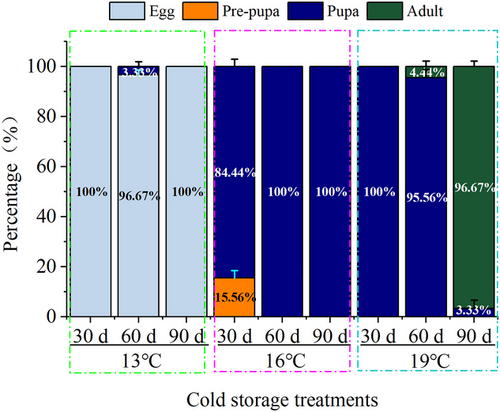
A temperature of 13 °C was not suitable for the storage of A. calandrae eggs. At this temperature, after 30 d of cold storage, the emergence rate of A. calandrae was 0% (Table 1). In contrast, at 16 or 19 °C, A. calandrae eggs underwent development and pupation, and the emergence rate increased to >94% after transfer to the appropriate temperature. Parasitoid wasps stored at 16 or 19 °C showed normal emergence, with a deformity rate of 0%. However, the survival rate of A. calandrae decreased with prolonged storage time. In particular, at 19 °C, 97% of the parasitoid wasps emerged prematurely during the 90-d storage period. This was not the desired outcome because adults were not considered an ideal developmental stage for cold storage. These findings demonstrate that A. calandrae can be stored for a longer period at 16 °C, even though their emergence rate decreases to 77% after 90 d of cold storage.
| Emergence proportion (%) | Emergence deformity proportion (%) | |||||
|---|---|---|---|---|---|---|
| Temperature (°C) | 30 d | 60 d | 90 d | 30 d | 60 d | 90 d |
| 13 | 0 B b | 3 ± 2 B b | 0 B c | – | 75 ± 19 a | – |
| 16 | 99 ± 1 A a | 94 ± 3 A a | 77 ± 2 B b | 0 | 0 b | 0 |
| 19 | 99 ± 1 A a | 96 ± 2 A a | 3 ± 3 B c | 0 | 0 b | 0 |
| 25 | 100 A a | 0 b | ||||
- Data are presented as means ± standard error. Different lowercase letters indicate statistically significant differences among treatments with the same storage period but different temperatures. Different uppercase letters indicate statistically significant differences among treatments with the same temperature but with different storage periods (0.05 significance level, Tukey's honestly significant difference test). “–” indicates unavailable data. During storage at 19 °C, parasitic wasps that had emerged prematurely were considered dead. Anisopteromalus calandrae reared at 25 °C without cold storage were used as the control group.
We also recorded the development-eclosion time after transferring A. calandrae from cold storage to a suitable temperature (emergence time). To clearly illustrate the developmental stage of A. calandrae after cold storage, we compared the development-eclosion time with the emergence time of A. calandrae on the first d of pupation. After 30 d of cold storage at 16 or 19 °C, a statistically significant difference of <1 d was noted in the emergence time (Fig. 2A, B). However, with an increase in the cold storage duration, the emergence time gradually shortened, particularly at 19 °C (Fig. 2C, D). Compared with the control group, no significant difference was observed in the emergence time of A. calandrae stored at 16 °C for 90 d (Fig. 2E, F). These results indicate that A. calandrae eggs can hatch and develop during cold storage at 16 °C, but the development ceases once they reach the early pupal stage.
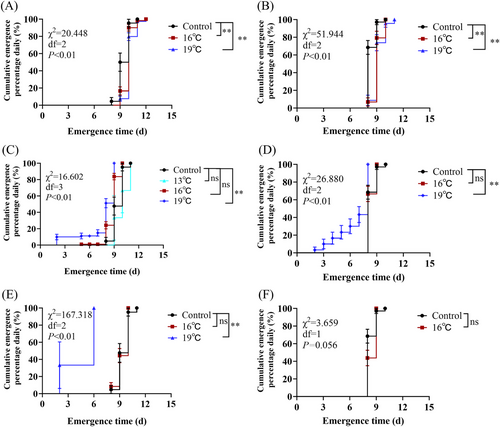
Compared with the control group, no significant difference was observed in the longevity (16 °C: χ2 = 5.364, P = 0.147; 19 °C: χ2 = 1.643, P = 0.440) (Fig. 3A, B), egg production (Fig. 3C, D), and the female offspring ratio of the F0 generation of A. calandrae after varying durations of cold storage. The average longevity of female wasps was 22 d, with an egg production of 147 and a female offspring ratio of 58%.
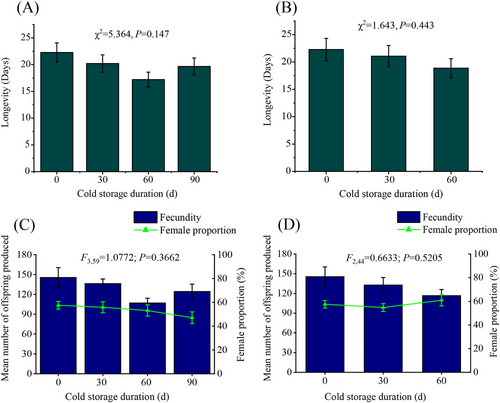
Effect of cold storage on the fitness of the F1 generation of A. calandrae
Various life table parameters of the F1 generation of A. calandrae were estimated and statistically analyzed after cold storage at 19 °C (data provided in the Supporting Information) and 16 °C. After cold storage treatment, significant differences were observed in the developmental durations of the F1 generation of A. calandrae in egg and pupal stages compared with those in the control group (P < 0.05) (Table 2 and Table S1). However, the differences in their developmental durations were all <1 d (Table 2 and Table S1). In addition, there were no significant differences in the developmental durations of the F1 generation of A. calandrae in the remaining stages (Table 2 and Table S1).
| Control | 16 °C, 30 d | 16 °C, 60 d | 16 °C, 90 d | |||||
|---|---|---|---|---|---|---|---|---|
| Parameters | n | Mean ± SE | n | Mean ± SE | n | Mean ± SE | n | Mean ± SE |
| Egg stage duration (d) | 40 | 1.0 ± 0.0 b | 40 | 1.2 ± 0.1 a | 40 | 1.2 ± 0.1 a | 40 | 1.3 ± 0.1 a |
| Larva stage duration (d) | 35 | 5.2 ± 0.1 a | 37 | 5.1 ± 0.1 a | 33 | 5.0 ± 0.1 a | 36 | 4.9 ± 0.1 a |
| Pupa stage duration (d) | 35 | 9.5 ± 0.1 a | 37 | 9.5 ± 0.1 a | 33 | 9.0 ± 0.1b | 36 | 9.1 ± 0.2 b |
| Male stage duration (d) | 20 | 15.9 ± 0.7 a | 22 | 16.2 ± 0.6 a | 18 | 16.2 ± 0.5 a | 21 | 16.1 ± 0.5 a |
| Female stage duration (d) | 15 | 22.9 ± 2.0 a | 15 | 20.4 ± 1.4 a | 15 | 22.7 ± 1.7 a | 15 | 21.7 ± 0.9 a |
| Oviposition days (d) | 15 | 21.3 ± 1.9 a | 15 | 17.9 ± 1.4 a | 15 | 21.5 ± 1.7 a | 15 | 20.1 ± 0.9 a |
| Total longevity (d) | 40 | 30.7 ± 2.0 a | 40 | 31.4 ± 1.5 a | 40 | 28.8 ± 2.1 a | 40 | 30.6 ± 1.6 a |
- Standard error (SE) was estimated using the bootstrap technique with 100 000 resampling. Means were compared using the paired bootstrap test. Different lowercase letters among peers indicate a significant difference between the two treatment groups (P < 0.05).
Statistical results indicated that cold storage at 16 °C (Table 3) or 19 °C (Table S2) had virtually no significant impact on the fecundity, adult preoviposition period (APOP), total preoviposition period (TPOP), net reproductive rate, intrinsic rate of increase (r), and finite rate of increase of the F1 generation of A. calandrae.
| Control | 16 °C, 30 d | 16 °C, 60 d | 16 °C, 90 d | |||||
|---|---|---|---|---|---|---|---|---|
| Parameters | n | Mean ± SE | n | Mean ± SE | n | Mean ± SE | n | Mean ± SE |
| Adult preoviposition period (APOP) (d) | 15 | 0 a | 15 | 0 a | 15 | 0.5 ±0.2 a | 15 | 0.5 ±0.2 a |
| Total preoviposition period (TPOP) (d) | 15 | 16.6 ± 0.2 a | 15 | 16.3 ± 0.1 a | 15 | 16.5 ± 0.3 a | 15 | 16.5 ± 0.3 a |
| Fecundity (F) (eggs per female) | 15 | 146 ± 15 a | 15 | 151 ± 11 a | 15 | 150 ± 12 a | 15 | 142 ± 6 a |
| Net reproductive rate (R0) (offspring per individual) | 40 | 55 ± 12 a | 40 | 57 ± 12 a | 40 | 56 ± 12 a | 40 | 53 ± 11 a |
| Mean generation time (T) (d) | 40 | 25.5 ± 0.6 a | 40 | 23.6 ± 0.4 b | 40 | 24.1 ± 0.5 a | 40 | 24.6 ± 0.4 a |
| Intrinsic rate of increase (r) (d−1) | 40 | 0.16 ± 0.01 a | 40 | 0.16 ± 0.01 a | 40 | 0.17 ± 0.01 a | 40 | 0.16 ± 0.01 a |
| Finite rate of increase (λ) (d−1) | 40 | 1.17 ± 0.01 a | 40 | 1.19 ± 0.01 a | 40 | 1.18 ± 0.01 a | 40 | 1.18 ± 0.01 a |
- Standard error (SE) was estimated using the bootstrap technique with 100 000 resamplings. Means were compared using the paired bootstrap test. Different lowercase letters among peers indicate a significant difference between the two treatment groups (P < 0.05).
After cold storage at 16 °C (Fig. 4) and 19 °C (Fig. S1), the probability of the survival of A. calandrae F0 generation's newly laid eggs until the adult stage was similar. An evident overlap was noted between the different developmental stages. The emergence of male adults generally preceded that of females, but the longevity of male adults was shorter than that of females.
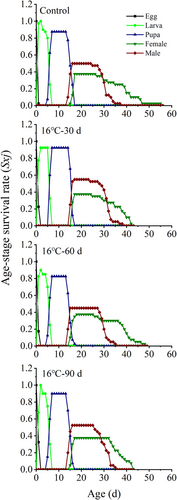
The age-specific survival rate (lx) curve of the F1 generation of A. calandrae after different durations of cold storage at 16 °C (Fig. 5) and 19 °C (Fig. S2) showed a similar trend, with mortality primarily occurring during the egg stage. This was mainly due to the need for dissecting L. serricorne cocoons to facilitate the observation of different developmental stages of A. calandrae. However, concurrently, the newly hatched A. calandrae larvae often crawled out of the host and perished. The age-specific fecundity (fxj) curve of the F1 generation of A. calandrae in each treatment group exhibited a multi-peaked, wavelike pattern, with a daily peak oviposition reaching 12.6 individuals.
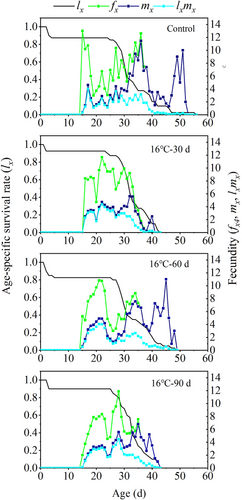
The age-stage-specific life expectancy (exj) of females in the control group (56 d) was longer than that in other treatment groups (16 °C: Fig. 6; 19 °C: Fig. S3). However, the longevity of females in other developmental stages showed little difference compared with that in the control group. This discrepancy may be related to the daily egg laying rate of females, as higher daily egg laying rates might imply reduced longevity. The value of specific reproductive value (vxj) progressively increased with advancing age and developmental stage (16 °C: Fig. 7; 19 °C: Fig. S4). The peak value of the vxj curve was observed around d 20.
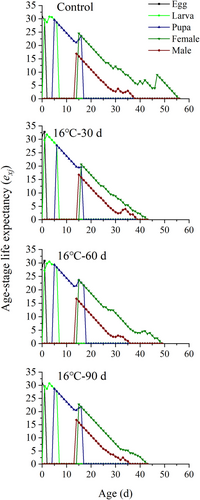
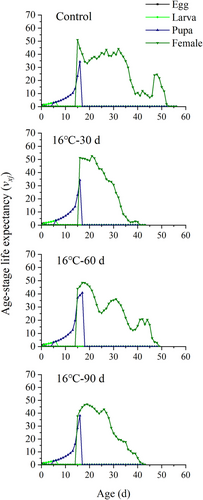
Discussion
Temperature plays an important role in the growth and development of parasitoid wasps (Hance et al., 2007; Furlong & Zalucki, 2017). Our study results indicated that the eggs of the parasitoid wasp A. calandrae are unlikely to hatch at 13 °C. With prolonged cold storage time at 13 °C, the eggs shrivel and die. Research on the developmental temperature of A. calandrae has indicated a lower threshold of 11.5 °C, with no development occurring at 12 °C (Mobarakian et al., 2014). A previous study indicated that the developmental threshold temperature of A. calandrae eggs is 16.14 °C (Guo et al., 2018). Our results also revealed the developmental characteristics of A. calandrae stored at 16 °C. At this temperature, A. calandrae eggs can hatch and their larvae can develop into pupae by feeding on L. serricorne larvae during cold storage, with development ceasing once A. calandrae eggs enter the pupal stage. This developmental pattern is consistent with the results of Guo et al. (2018) (eggs T0 = 16.14 °C; larvae T0 = 16.04 °C; pupae T0 = 17.81 °C). Other studies have also indicated that a temperature range of 17.7–36.2 °C is necessary for the development of A. calandrae (Chun et al., 1992).
Most of the existing cold storage studies on insects have primarily focused on the effects of cold storage at relatively low temperatures on 1 or more specific developmental stages of insects (e.g., eggs, larvae, pupae or adults) (Colinet & Boivin, 2011; Morales-Ramos et al., 2023). However, only a few studies have explored the determination of a relatively mild cold storage temperature using a “development-arrest” strategy. This strategy allows insects to complete a developmental stage under the same conditions to improve survival rates and subsequently cease their development at a specific stage (e.g., reaching an overwintering stage), thereby achieving long-term storage. However, the cold storage conditions selected in those studies are only suitable for a specific developmental stage, which is inconvenient in actual practice. A previous study indicated that A. calandrae can be stored at 13 °C for up to 90 d (Yang et al., 2024). However, this temperature condition is only suitable for the cold storage of early pupae because A. calandrae eggs cannot complete development at 13 °C. Although cold storage of parasitoid adults is more convenient than that of other developmental stages as it allows for the rapid and direct release of parasitoid wasps for pest control, the cold storage of adult A. calandrae is not considered ideal. This is because after 3 weeks of storage at 15 °C, their survival rate reaches only 73%, and prolonged storage significantly impacts their biological performance (Guo et al., 2023). Our study results suggested cold storage conditions for A. calandrae that are suitable for a broader range of developmental stages of A. calandrae. We demonstrated that A. calandrae eggs can hatch and their larvae can complete development into pupae at 16 °C. Additionally, upon reaching the pupal stage, their development ceases. In other words, A. calandrae can be stored at 16 °C across all developmental stages before reaching the early pupal stage, enabling the long-term storage of A. calandrae, which may reduce management costs for the mass production and cold storage of A. calandrae. We believe that the abovementioned research strategy has the potential to be expanded to cold storage studies on other parasitoid wasps, particularly endoparasitoids. The pupal stage is typically considered a transitional phase for insects to endure adverse environmental conditions, representing a selective advantage of holometabolous insects, as it allows for better buffering against environmental variability (Ross et al., 2000). In-depth research on developmental arrest during the pupal stage can reveal the molecular and physiological mechanisms underlying the development of nondiapause parasitoid wasps under cold storage conditions.
Achieving a high survival rate is considered a key requirement for successful cold storage of insects (Leopold, 2007). However, the survival rate is influenced by several factors, such as the mildness of the storage temperature, duration of cold storage, and adaptability of the parasitoid wasp itself (Colinet & Boivin, 2011). Therefore, we need to develop appropriate cold storage strategies for different species. Our results indicated that the survival rate of A. calandrae decreases to some extent after 90 d of cold storage at 16 °C, but it remains at 78%. We believe that this duration meets our expectations because, in nature, A. calandrae may experience overwintering periods of > 3 months. The research findings indicate that the pollinator Osmia excavata can be stored at 0 °C for up to 120 d with a survival rate exceeding 90%, and this has no significant impact on its average flight speed (Song et al., 2024). Some parasitoid wasps can be stored for a particularly long period; for instance, Pteromalus puparum can still produce viable offspring after cold storage for 15 months at 10 °C (McDonald & Kok, 1990). To improve the survival rate of organisms during cold storage, some strategies involve providing suitable high-temperature conditions during storage to reduce the damage caused by low temperature conditions. The fluctuating thermal regime can repair putative cold-induced membrane alterations or to change membrane structure to optimize and maintain functions at low temperature (Colinet et al., 2018). Related research, such as Aphidius colemani (Colinet et al., 2006; Colinet & Hance, 2009). However, it remains unexplored whether this cold storage method can be widely applied to various species. In nature, some species such as A. colemani are active in open fields and experience large temperature variations. In contrast, other species, such as the parasitoid wasp A. calandrae, are active year-round in relatively enclosed warehouse environments, with more stable temperatures and smaller temperature differences. These species exist in 2 different macro environments, which may have led to their varying adaptations to temperature. If a higher survival rate is desired, we recommend moderately shortening the cold storage duration.
It is also important to determine the time required for parasitoid wasps to develop into adults after cold storage. This can help researchers decide when to remove the wasps for development and emergence, indicating a time appropriate for pest control. Our results showed that after storing A. calandrae eggs at 16 or 19 °C for 30 d, most of them completed pupation and remained in the early pupal stage. After transferring to environments with a temperature of 25 °C, the time required by A. calandrae pupae to develop into adults was similar to that in the control group. However, some parasitoid wasps have longer or shorter emergence times after cold storage, depending on the storage conditions (Luczynski et al., 2007; Colinet & Boivin, 2011). If the cold storage temperature is extremely high and the parasitoid wasps can develop during storage, the emergence time after cold storage will be relatively shorter, as observed in Anagyrus ananatis Gahan (Pandey & Johnson, 2005). If the cold storage temperature is low and the storage is extremely prolonged, causing some cold damage to parasitoid wasps, they may take longer to develop into adults after cold storage (Whitaker-Deerberg et al., 1994; Yang et al., 2024). Numerous studies have attempted to understand the mechanisms of developmental arrest and survival in insects at low temperatures using modern molecular techniques such as transcriptomics, proteomics, and metabolomics. These studies have predicted many candidate genes, including those involved in histone modification, hormone signaling, nervous system development, and circadian clock genes, such as heat shock protein, insulin-like peptide, or target of rapamycin genes (King & MacRae, 2015; Miki et al., 2020; van Dis et al., 2022). Based on the current knowledge, despite common threads, the molecular mechanisms of winter survival vary considerably across species, and taxonomic biases must be addressed to fully understand the mechanistic basis of developmental arrest and survival at low temperatures across the insect phylogeny (Teets & Denlinger, 2013; Hayward et al., 2014; Overgaard & MacMillan, 2017; Teets et al., 2023).
A. calandrae injects venom into the host with its needle-like ovipositor, paralyzing the host, and then lays eggs on the host body's surface (Zhang et al., 2022). The hatched larvae slowly feed on the host, eventually killing it (Guo et al., 2018). Therefore, in practical applications, the ability to lay eggs is one of the main parameters that best reflect the parasitic ability of parasitoid wasps. In cold storage research, factors that affect the reproductive capacity of parasitic wasps, in addition to storage temperature and storage time, can directly influence the utilization efficiency of the host under low temperature environment, as the host is the direct energy source of parasitic wasps. For example, the reproductive capacity of Trichogramma ostriniaemie feeding on Corcyra cephalonica eggs at low temperatures (17 °C) is significantly lower than at normal temperatures (Saljoqi & He, 2004). In the current study, A. calandrae larvae hatched at 16 °C can feed on L. serricorne larvae to complete their development and pupate. Meanwhile, our results indicated that storing A. calandrae eggs at 16 °C for <90 d does not adversely affect their fecundity and sex ratio. Our previous study revealed similar results, revealing that storing early pupae of A. calandrae at 13 °C for ≤90 d does not significantly affect their reproductive capacity (Yang et al., 2024), indicating that the immature stages of A. calandrae are more suitable for cold storage, as adults can only be stored for ≤3 weeks at 15 °C (Guo et al., 2023). Overall, these results provide potential for the large-scale breeding and commercial production of A. calandrae, offering more flexible options for its application in the control of warehouse pests.
The 2-sex life table is a statistical tool used to describe the probabilities of the survival and reproduction of individuals of different sexes at different ages (Chi et al., 2020, 2022). It provides valuable information about the population structure and dynamics of a species, facilitating the understanding of the growth, survival, and reproductive capacities of individuals of different sexes of the species (Chi et al., 2023). This, in turn, aids in a deeper understanding of the biological characteristics and ecological fitness of the species (Chi et al., 2022). We used the 2-sex life table to evaluate the fitness of the F1 generation of A. calandrae after cold storage. The results indicated that cold storage has almost no adverse effects on the development and reproduction of the F1 generation. Similar cold storage research has indicated that the detrimental effects of cold storage on the parental generation do not extend to the subsequent generation (Chen et al., 2008, 2011).
This study demonstrates that A. calandrae eggs can hatch at 16 °C and that the newly hatched larvae can complete their development and pupate by feeding on L. serricorne larvae. Once A. calandrae enters the pupal stage, the development ceases, enabling cold storage for up to 90 d. In addition, cold storage has no adverse effects on the F1 generation of A. calandrae. Considering large-scale breeding and storage, this method provides a more convenient and straightforward approach for producing A. calandrae while also extending its cold storage period. This advancement holds significant promise for the future large-scale production of A. calandrae.
Acknowledgments
This study was supported by the Program of Excellent Innovation Talents,Guizhou Province, China (grant number 20206003-2).
Disclosure
The authors declare they have no known competing financial interests or personal relationships that could have appeared to influence the work reported in this paper.



